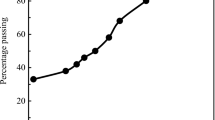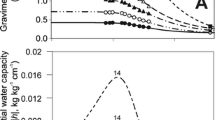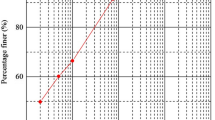Abstract
This paper presents a comprehensive investigation on the microstructural evolutions of expansive clay during a drying–wetting cycle, including pore size distribution (PSD) via mercury intrusion porosimetry and water distribution via nuclear magnetic resonance (NMR). The soil water characteristic curves at different soil densities and soil shrinkage curve are also obtained, and a threshold suction can be identified to distinguish the adsorptive and capillary regimes of pore water. Combined with the water distribution obtained by the NMR technique, the evolutions of the adsorptive water and capillary water during drying–wetting cycle were addressed. The measured PSD curves of the expansive soils at different suctions showed two distinct peaks, corresponding to micropores and macropores, respectively. Both variations of macropores and micropores are irreversible during the wetting–drying cycle, which partly explain the adsorptive water content decreasing when the suction is small.













Similar content being viewed by others
References
Al-Mukhtar M, Belanteur N, Tessier D, Vanapalli SK (1996) The fabric of a clay soil under controlled mechanical and hydraulic stress states. Appl Clay Sci 11(2–4):99–115. https://doi.org/10.1016/S0169-1317(96)00023-3
Bayer JV, Jaeger F, Schaumann GE (2010) Proton nuclear magnetic resonance (NMR) relaxometry in soil science applications. Open Magn Reson J 3:15–26. https://doi.org/10.2174/1874769801003010015
Bird NRA, Preston AR, Randall EW, Whalley WR, Whitmore AP (2005) Measurement of the size distribution of water-filled pores at different matric potentials by stray field nuclear magnetic resonance. Eur J Soil Sci 56:135–143. https://doi.org/10.1111/j.1351-0754.2004.00658.x
Burton GJ, Pineda JA, Sheng DC, Airey D (2015) Microstructural changes of an undisturbed, reconstituted and compacted high plasticity clay subjected to wetting and drying. Eng Geol 193:363–373. https://doi.org/10.1016/j.enggeo.2015.05.010
Casini F, Vaunat J, Romero E, Desideri A (2012) Consequences on water retention properties of double-porosity features in a compacted silt. Acta Geotech 7(2):139–150. https://doi.org/10.1007/s11440-012-0159-6
Cheng K, Heidari Z (2017) Combined interpretation of NMR and TGA measurements to quantify the impact of relative humidity on hydration of clay minerals. Appl Clay Sci 143:362–371. https://doi.org/10.1016/j.clay.2017.04.006
Cuisinier O, Laloui L (2004) Fabric evolution during hydromechanical loading of a compacted silt. Int J Numer Anal Methods Geomech 28(6):483–499. https://doi.org/10.1002/nag.348
Delage P, Audiguier M, Cui YJ, Howat MD (1996) Microstructure of a compacted silt. Can Geotech J 33(1):150–158. https://doi.org/10.1139/t96-030
Delage P, Marcial D, Cui YJ, Ruiz X (2006) Ageing effects in a compacted bentonite: a microstructure approach. Géotechnique 56(5):291–304. https://doi.org/10.1680/geot.2006.56.5.291
Diamond S (1970) Pore size distributions in clays. Clay Clay Miner 18(1):7–23. https://doi.org/10.1346/CCMN.1970.0180103
Dong Y, Lu N (2017) Measurement of suction-stress characteristic curve under drying and wetting conditions. Geotech Test J 40(1):107–121. https://doi.org/10.1520/GTJ20160058
Fleury M, Kohler E, Norrant F, Gautier S, M’Hamdi J, Barré L (2013) Characterization and quantification of water in smectites with low-field NMR. J Phys Chem C 117(9):4551–4560. https://doi.org/10.1021/jp311006q
Jaeger F, Shchegolikhina A, van As H, Schaumann G (2010) Proton NMR relaxometry as a useful tool to evaluate swelling processes in peat soils. Open Magn Reson J 3:27–45. https://doi.org/10.2174/1874769801003010027
Koliji A, Laloui L, Cusinier O, Vulliet L (2006) Suction induced effects on the fabric of a structured soil. Transport Porous Med 64(2):261–278. https://doi.org/10.1007/s11242-005-3656-3
la Morena GD, Asensio L, Navarro V (2018) Intra-aggregate water content and void ratio model for MX-80 bentonites. Eng Geol 246:131–138. https://doi.org/10.1016/j.enggeo.2018.09.028
Lebeau M, Konrad JM (2010) A new capillary and thin film flow model for predicting the hydraulic conductivity of unsaturated porous media. Water Resour Res 46:W12554. https://doi.org/10.1029/2010WR009092
Liu XF, Buzzi O, Yuan SY, Mendes J, Fityus S (2016) Multi-scale characterization of retention and shrinkage behaviour of four Australian clayey soils. Can Geotech J 53(5):854–870. https://doi.org/10.1139/cgj-2015-0145
Liu XF, de Carteret R, Buzzi OP, Fityus SG (2016) Microstructural effects of environmental salinity on unbound granular road pavement material upon drying. Acta Geotech 11(2):445–451. https://doi.org/10.1007/s11440-015-0393-9
Lloret A, Villar MV (2007) Advances on the knowledge of the thermo-hydro-mechanical behaviour of heavily compacted “FEBEX” bentonite. Phys Chem Earth 32(8–14):701–715. https://doi.org/10.1016/j.pce.2006.03.002
Lu N, Dong Y (2017) Correlation between soil-shrinkage curve and water-retention characteristics. J Geotech Geoenviron 143(9):04017054. https://doi.org/10.1061/(ASCE)GT.1943-5606.0001741
Lu N, Khorshidi M (2015) Mechanisms for soil-water retention and hysteresis at high suction range. J Geotech Geoenviron 141(8):04015032. https://doi.org/10.1061/(ASCE)GT.1943-5606.0001325
Lu N, Likos WJ (2004) Unsaturated soil mechanics. Wiley, New York
Monroy R, Zdravkovic L, Ridley A (2010) Evolution of microstructure in compacted London Clay during wetting and loading. Géotechnique 60(2):105–119. https://doi.org/10.1680/geot.8.P.125
Musso G, Romero E, Vecchia GD (2013) Double-structure effects on the chemo-hydro-mechanical behaviour of a compacted active clay. Géotechnique 63(3):206–220. https://doi.org/10.1680/geot.SIP13.P.011
Nowamooz H, Masrouri F (2010) Relationships between soil fabric and suction cycles in compacted swelling soils. Eng Geol 114(3–4):444–455. https://doi.org/10.1016/j.enggeo.2010.06.005
Ohkubo T, Ibaraki M, Tachi Y, Iwadate Y (2016) Pore distribution of water-saturated compacted clay using NMR relaxometry and freezing temperature depression; effects of density and salt concentration. Appl Clay Sci 123:148–155. https://doi.org/10.1016/j.clay.2016.01.014
Or D, Tuller M (1999) Liquid retention and interfacial area in variably saturated porous media: upscaling from single-pore to sample-scale model. Water Resour Res 35(12):3591–3605. https://doi.org/10.1029/1999WR900262
Prost R, Koutit T, Benchara A, Huard E (1998) State and location of water adsorbed on clay minerals: consequences of the hydration and swelling shrinkage phenomena. Clay Clay Miner 46(2):117–131. https://doi.org/10.1346/CCMN.1998.0460201
Rhaiem H, Tessier D, Pons C, Amara A (1998) Evolution of the microstructure of interstratified Ca-saturated clays during dehydration: SAXS and HRTEM analysis. Clay Miner 33:619–628. https://doi.org/10.1180/claymin.1998.033.4.09
Romero E (2013) A microstructural insight into compacted clayey soils and their hydraulic properties. Eng Geol 165:3–19. https://doi.org/10.1016/j.enggeo.2013.05.024
Romero E, Simms PH (2008) Microstructure investigation in unsaturated soils: a review with special attention to contribution of mercury intrusion porosimetry and environmental scanning electron microscopy. Geotech Geol Eng 26(6):705–727. https://doi.org/10.1007/s10706-008-9204-5
Romero E, Vecchia GD, Jommi C (2011) An insight into the water retention properties of compacted clayey soils. Géotechnique 61(4):313–328. https://doi.org/10.1680/geot.2011.61.4.313
Sasanian S, Newson TA (2013) Use of mercury intrusion porosimetry for microstructural investigation of reconstituted clays at high water contents. Eng Geol 158:15–22. https://doi.org/10.1016/j.enggeo.2013.03.002
Seiphoori A, Ferrari A, Laloui L (2014) Water retention behavior and microstructural evolution of MX-80 bentonite during wetting and drying cycles. Géotechnique 64(9):721–734. https://doi.org/10.1680/geot.14.P.017
Simms PH, Yanful EK (2001) Measurement and estimation of pore shrinkage and pore distribution in a clayey till during soil–water characteristic curve tests. Can Geotech J 38(4):741–754. https://doi.org/10.1139/t01-014
Sun WJ, Cui YJ (2017) Investigating the microstructure changes for silty soil during drying. Géotechnique 68(4):370–373. https://doi.org/10.1680/jgeot.16.P.165
Tian HH, Wei CF, Lai YM, Chen P (2017) Quantification of water content during freeze–thaw cycles: a nuclear magnetic resonance based method. Vadose Zone J 17:160124. https://doi.org/10.2136/vzj2016.12.0124
Todoruk TR, Langford CH, Kantzas A (2003) Pore-scale redistribution of water during wetting of air-dried soils as studied by low-field NMR relaxometry. Environ Sci Technol 37:2707–2713. https://doi.org/10.1021/es025967c
Tokunaga TK (2011) Physicochemical controls on adsorbed water film thickness in unsaturated geological media. Water Resour Res 47:W08514. https://doi.org/10.1029/2011WR010676
Tuller M, Or D (2005) Water films and scaling of soil characteristic curves at low water contents. Water Resour Res 41:W09403. https://doi.org/10.1029/2005WR004142
Vilarrasa V, Rutqvist J, Martin LB, Birkholzer J (2015) Use of a dual-structure constitutive model for predicting the long-term behavior of an expansive clay buffer in a nuclear waste repository. Int J Geomech 16(6):D4015005. https://doi.org/10.1061/(ASCE)GM.1943-5622.0000603
Wei X, Hattab M, Fleureau JM, Hu R (2013) Micro-macro-experimental study of two clayey materials on drying paths. B Eng Geol Environ 72(3):495–508. https://doi.org/10.1007/s10064-013-0513-4
Yuan SY, Liu XF, Sloan SW, Buzzi OP (2016) Multi-scale characterization of swelling behaviour of compacted Maryland clay. Acta Geotech 11(4):789–804. https://doi.org/10.1007/s11440-016-0457-5
Zhang Y, Ye WM, Chen YG, Chen B (2017) Impact of NaCl on drying shrinkage behavior of low-plasticity soil in earthen heritages. Can Geotech J 54(12):1762–1774. https://doi.org/10.1139/cgj-2016-0403
Zhang JR, Niu G, Li XC, Sun DA (2020) Hydro-mechanical behavior of expansive soils with different dry densities over a wide suction range. Acta Geotech 15:265–278. https://doi.org/10.1007/s11440-019-00874-y
Zhao NF, Ye WM, Chen B, Chen YG, Cui YJ (2019) Modeling of the swelling–shrinkage behavior of expansive clays during wetting–drying cycles. Acta Geotech 14:1325–1335. https://doi.org/10.1007/s11440-018-0718-6
Acknowledgements
The research was supported by the National Natural Science Foundation of China (NSFC) under Grants 41972290, 41877269 and 51639008, and the Hubei Provincial Natural Science Foundation of China under Grant 2017CFB225.
Author information
Authors and Affiliations
Corresponding author
Additional information
Publisher's Note
Springer Nature remains neutral with regard to jurisdictional claims in published maps and institutional affiliations.
Rights and permissions
About this article
Cite this article
Ma, T., Wei, C., Yao, C. et al. Microstructural evolution of expansive clay during drying–wetting cycle. Acta Geotech. 15, 2355–2366 (2020). https://doi.org/10.1007/s11440-020-00938-4
Received:
Accepted:
Published:
Issue Date:
DOI: https://doi.org/10.1007/s11440-020-00938-4




